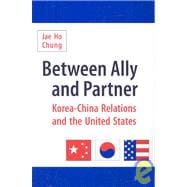
Note: Supplemental materials are not guaranteed with Rental or Used book purchases.
Purchase Benefits
What is included with this book?
| List of Tables | p. ix |
| Preface | p. xi |
| The Rise of Korea-China Relations and the United States | p. 1 |
| The "Rise" of China and Its Impact on Neighbors | p. 2 |
| From Confrontation to Cooperation: The Case of South Korea-China Relations | p. 4 |
| The Evolution of Sino-South Korean Cooperation: A Literature Review | p. 6 |
| The Focus of the Book | p. 8 |
| The Structure of the Volume | p. 10 |
| A Sketch of Sino-Korean Relations | p. 12 |
| A "Special" Relationship in Geopolitical Time | p. 13 |
| South Korea and China: A Contemporary Puzzle | p. 16 |
| Perspectives on the Origins of the South Korea-China Rapprochement | p. 19 |
| Strategic Accommodation by Minimizing Systemic Constraints | p. 20 |
| Envisioning an Interdependent Trading State | p. 21 |
| Reform and Opening: Linking the Changes from Within | p. 23 |
| South Korea-China Relations Before 1988 | p. 29 |
| Sino-South Korean Relations Before 1979 | p. 29 |
| The Initiation Phase, 1979-1983 | p. 32 |
| The Expansion Phase, 1984-1987 | p. 34 |
| Patterns of Sino-South Korean Trade, 1979-1987 | p. 35 |
| South Korea's Investment in China, 1984-1987 | p. 39 |
| The Political Limits of Sino-South Korean Relations | p. 41 |
| The Political Economy of Rapprochement, 1988-1992 | p. 43 |
| The Takeoff Phase, 1988-1990 | p. 43 |
| The Normalization Phase, 1991-1992 | p. 45 |
| Sino-South Korean Trade, 1988-1992 | p. 47 |
| South Korean Investment in China, 1988-1992 | p. 49 |
| The Infrastructure of South Korea-China Bilateralism | p. 51 |
| The External Constraints on Sino-South Korean Bilateralism | p. 53 |
| The Politics of Normalization: Actors, Processes, and Issues | p. 56 |
| Top Leaders and Informal Channels | p. 56 |
| Factors of Bureaucratic Politics | p. 62 |
| Operation East Sea: Facts and Lessons | p. 69 |
| Beyond Normalization: South Korea and China in the Post-Cold War Era | p. 75 |
| Post-Cold War Northeast Asia in Flux | p. 75 |
| Postnormalization Sino-South Korean Relations: Compatibility, Competition, and Cooperation | p. 78 |
| Beyond Economics: Strategic Compatibility? | p. 84 |
| The South Korean Variable: Divided Allegiance? | p. 90 |
| The Rise of China and the U.S.-South Korean Alliance Under Strain | p. 92 |
| China's Rise Over South Korea | p. 93 |
| South Korea's Views of China and the United States | p. 96 |
| Perceptual Ambivalence Toward China | p. 100 |
| The U.S.-South Korea Alliance Under Strain: Room for Wedging? | p. 102 |
| Between Dragon and Eagle: Korea at the Crossroads | p. 108 |
| The Future of China: Beyond Simple Dichotomy | p. 109 |
| The Menu of Choices and Rational Constraints | p. 112 |
| Parameters of South Korea's Choice: Where the United States and China Converge | p. 116 |
| Walking the Tightrope: The Choice of Not Making Choices | p. 119 |
| Notes | p. 123 |
| Index | p. 181 |
| Table of Contents provided by Ingram. All Rights Reserved. |
The New copy of this book will include any supplemental materials advertised. Please check the title of the book to determine if it should include any access cards, study guides, lab manuals, CDs, etc.
The Used, Rental and eBook copies of this book are not guaranteed to include any supplemental materials. Typically, only the book itself is included. This is true even if the title states it includes any access cards, study guides, lab manuals, CDs, etc.